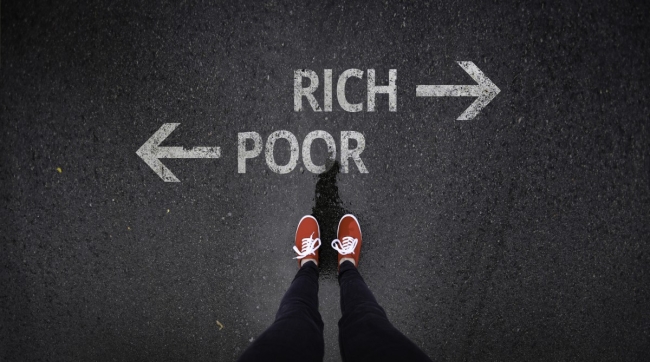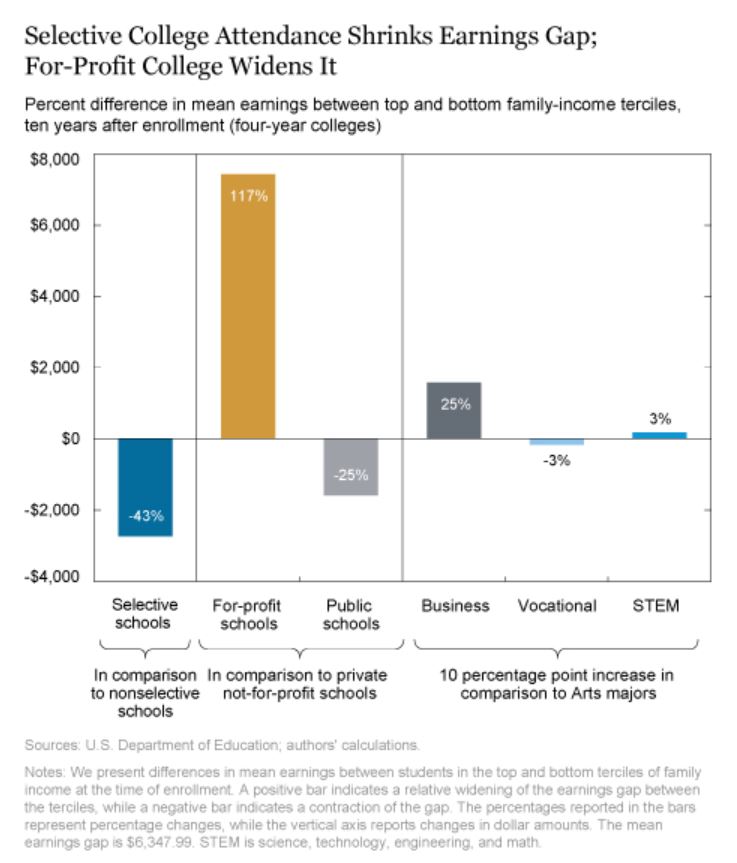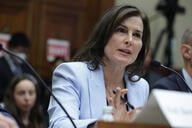You have /5 articles left.
Sign up for a free account or log in.

Istockphoto.com/pick-uppath
Attending a selective college narrows the earnings gap between students from the richest and poorest backgrounds, finds a new analysis from a Federal Reserve Bank of New York economist and analyst. So does attending a public college.
On the other hand, attending a for-profit college sharply widens the gap.
Those findings stand out in a Wednesday post titled “Education’s Role in Earnings, Employment, and Economic Mobility” on the New York Fed’s “Liberty Street Economics” blog. The post also reported that students who enrolled in selective colleges went on to earn more in a decade’s time than those who attended nonselective colleges, and that those who attended for-profit colleges earned significantly less in that time frame than did those who attended private not-for-profit colleges.
The results could prove to be an important addition to the discussion unfolding as the U.S. Department of Education moves away from gainful-employment rules that arguably would have curtailed what critics saw as predatory for-profit colleges. They also show how important it is that students have information available about their choice of college and major, wrote the blog post’s authors, Rajashri Chakrabarti, a senior economist at the New York Fed, and Michelle Jiang, a former senior research analyst there.
“These findings have important implications for policy, specifically for ‘gainful employment’ regulations, which stipulate that educational programs must offer worthwhile preparation in a recognized occupation to be eligible for student-assistance funding under the Higher Education Act, and the recent start of a rollback of these provisions,” the authors wrote. “They also highlight the importance of the availability of information about college and major choices since these choices can matter not only for labor market outcomes but also in affecting income inequalities in the medium to long term.”
The authors sought to find out if the choice of a college and major affects employment and earnings, whether differences persist over time and whether some educational backgrounds promoted upward economic mobility more than others. They used data from the Department of Education to analyze labor market outcomes for freshman cohorts entering college between 1997 and 2007. They controlled for a number of variables like location of a college, cohort size, racial composition and parental education.
First, they examined whether college choice and major choice affected earnings and employment six years after enrollment. They found students who enrolled at selective colleges -- four-year colleges in the top three of six tiers in the 2001 edition of Barron’s Profiles of American Colleges -- posted an 11 percent earnings premium over similar students who attended nonselective colleges. Students who attended for-profit colleges earned 17 percent less than did those who attended private not-for-profit four-year colleges.
Cohorts with larger shares of students majoring in science, technology, engineering and mathematics or business, in comparison to arts and humanities majors, also increased their mean earnings.
The effect of college type on earnings was more pronounced 10 years after cohorts’ enrollment. After 10 years, students who enrolled in selective colleges had a 20 percent earnings premium over students who attended nonselective colleges. Those who attended for-profits earned 18 percent less than those who went to private not-for-profit institutions. STEM and business majors still boosted cohorts’ earnings.
But the effect of college type on whether students would hold a job was not nearly as large. After six years, students who had enrolled in selective colleges only had 1 percent higher employment than did those from nonselective colleges, and students from for-profit colleges were 4 percent less likely to be employed compared to students at private nonprofit colleges. The probabilities were similar in the 10-year time frame.
“This indicates that the quality of jobs, rather than the probability of employment, is more relevant for the broadening of the earnings distribution across individuals,” the authors wrote.
The findings on earnings line up with a significant amount of existing research, experts said. The choice of a college and major matters quite a bit, according to Douglas Webber, director of graduate studies and an associate professor at the Temple University Department of Economics & Institute for Labor Economics. He was intrigued by the findings on earnings inequality, he added.
“I would need to know more of the technical details of the analysis to really evaluate how solid the result that for-profits increase inequality and selective colleges reduce it by very large margins,” he wrote in an email. “That said, the numbers in that last figure are pretty striking.”
That figure, inserted above, illustrates how much smaller the earnings gap is between students from relatively wealthy and poor backgrounds who went to selective colleges -- and how much larger the gap is among students who attended for-profit colleges.
It compares the earnings gap 10 years after enrollment between the top and bottom thirds of students, as measured by family income at the time they enrolled in a four-year institution. The average earnings gap between the top third of students and bottom third across the sample was $6,348.
Attending a selective college cut the earnings gap by 43 percent, or $2,736, in comparison to attending a nonselective college. Attending a four-year public college cut the earnings gap by 25 percent, or $1,584, in comparison to attending a four-year private not-for-profit college.
In sharp contrast, attending a for-profit college increased the earnings gap by 117 percent, or $7,428, in comparison to attending a private not-for-profit college.
While the findings on selective and for-profit status deserve attention, advocates of public colleges said the results also cast those institutions in a good light.
“The analysis shows that public colleges and universities act as an equalizing force and help shrink the earnings gap between those in the top and bottom rungs of the income ladder,” said Thomas Harnisch, director of state relations and policy analysis at the American Association of State Colleges and Universities. “Public colleges and universities are a force for economic mobility.”
Students who had enrolled in public colleges posted slightly lower mean earnings than did those who attended private nonprofit colleges. But they still fared better than those attending for-profits. And many students attending public colleges enter careers that don’t pay particularly well but are valuable to society, like teaching, Harnisch said.
He also argued that the six- and 10-year time frames are only medium-term earnings that provide a limited snapshot of an adult’s lifetime potential. It is important to remember public colleges are affordable up front, he added.
“Students at the public colleges and universities will often pay a fraction of the tuition prices and have, on average, less student debt,” Harnisch said.
The findings add to stories surrounding both selective institutions and for-profit colleges, according to Sandy Baum, a fellow at the Urban Institute. Baum, who recently said Education Secretary Betsy DeVos misrepresented her work to try to justify eliminating the gainful-employment rule, said in an email that the new findings confirm that failing to adequately monitor and regulate the for-profit sector will likely have a negative impact on many students.
In other discussions, concerns are running high about selective colleges making inequality worse. But data from Stanford University economist Raj Chetty has suggested people from low-income backgrounds who attend selective colleges end up doing about as well as do more affluent students at those institutions, Baum said in an email.
“Data on undermatching indicate that similar students are more likely to complete bachelor’s degrees if they attend more selective institutions,” she said. “These findings add to that story -- going to a more selective institution also boots earnings prospects.”





